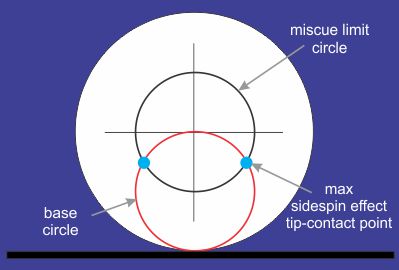What is a drag shot, and how does it affect sidespin?
A drag shot is one where CB sliding (from bottom spin, stun, or topspin less than full natural roll) is used to slow the CB on the way to the OB, resulting in the desired amount of draw, stun, or follow at the OB. As the CB drags across the cloth, any backspin gradually wears off, resulting in stun, and then the CB gradually develops complete forward roll. Here’s an illustration (from Patrick Johnson) that shows how backspin gradually transforms to stun and then natural roll:

The following video provides good illustrations of the “drag” action of the cloth, and the resulting spin conversion:
And here are some additional pertinent videos:
- HSV 3.1 – Stop-shot showing loss of bottom spin over distance
- HSV B.10 – MOFUDAT stroke drill follow and draw effects
- NV B.10 – Drag spin loss and sidespin persistence
Drag shots are used to:
- Limit table roll-off with a long, slow shot requiring CB roll at the OB. If you hit the CB below center, you can use more speed than is required at the OB. With faster speed (before the drag slowing), the CB will be less likely to roll off line due to a non-level table. The drag action makes the bottom spin wear off, slowing the CB; and with enough distance (or slow-enough speed), the CB will develop full roll before reaching the OB.
- Retain more sidespin (due to faster shot speed) and intensify sidespin (see below) to spin a ball in with a fuller hit and outside english. The intensified sidespin creates more spin-induced throw than normal.
- Intensify sidespin (see below) to create a greater rebound-angle change off a cushion than would otherwise be possible for a position play.
- Intensify sidespin (see below) allowing less tip offset to be used to create the desired amount of spin with correspondingly less squirt and swerve (which would otherwise require more aim compensation).
- Control the amount of forward rotation on the CB when it reaches the OB to help control the carom angle and/or distance traveled (e.g., to kill the CB as with this shot from Efren Reyes).
The following video shows demonstrations of each type of drag shot:
For drag shots with sidespin, very little sidespin is lost as the CB slows. This intensifies the effect of the sidespin (by increasing the spin-speed ratio). Here are some examples from Vol. II of the Video Encyclopedia of Eight Ball (VEEB):
For more information, see “VEEB – Part III: Drag-Enhanced Sidespin” (BD, January, 2016) and pages 26-28 in Ron Shepards pool physics document.
And here are some other examples:
The ideal tip contact point to get the largest effective sidespin is illustrated in the diagram below from Vol. IV of the Video Encyclopedia of Pool Shots (VEPS). It is at the intersection of the miscue-limit circle (black) and the base circle (red) of equal size going through the center and resting point of the CB. The tip isn’t as far from the vertical centerline of the CB as it would be at the miscue limit on the horizontal centerline (equator) of the CB, so the initial spin won’t be maximum; but the drag action created by the bottom spin increases the effective amount of sidespin due to the slowing of the CB. This tip contact point results in the largest effective sidespin only after all backspin has worn off and the CB has developed full roll. At that point the CB will have more effective sidespin (sidespin-to-speed ratio) than is possible with any other hit. Shot 501 in VEPS-IV demonstrates the effect at the table, and TP B.17 provides a math/physics-based proof. As proved in TP B.17, the required contact point for maximum sidespin effect is 30˚ below the CB horizontal equator, which corresponds to “4 o’clock” for right spin and “8 o’clock” for left spin.

Cloth drag can also have a large impact on draw and follow shots, with and without sidespin. For more info, see:
For more information on cloth conditions effects, see the cloth effects resource page.
Why is it easier to hit a stop shot than to draw or follow the CB a precise amount?
A stop shot can withstand a small amount of back or top spin with no or little CB motion; and at faster speed, the CB is close to sliding over a very large distance, resulting is stop action. With follow and draw shots, especially at faster speed, small changes in the amount of spin (top or bottom) have large effects on CB travel distance. So a stop shot has a much larger margin for error.
Dr. Dave keeps this site commercial free, with no ads. If you appreciate the free resources, please consider making a one-time or monthly donation to show your support:
